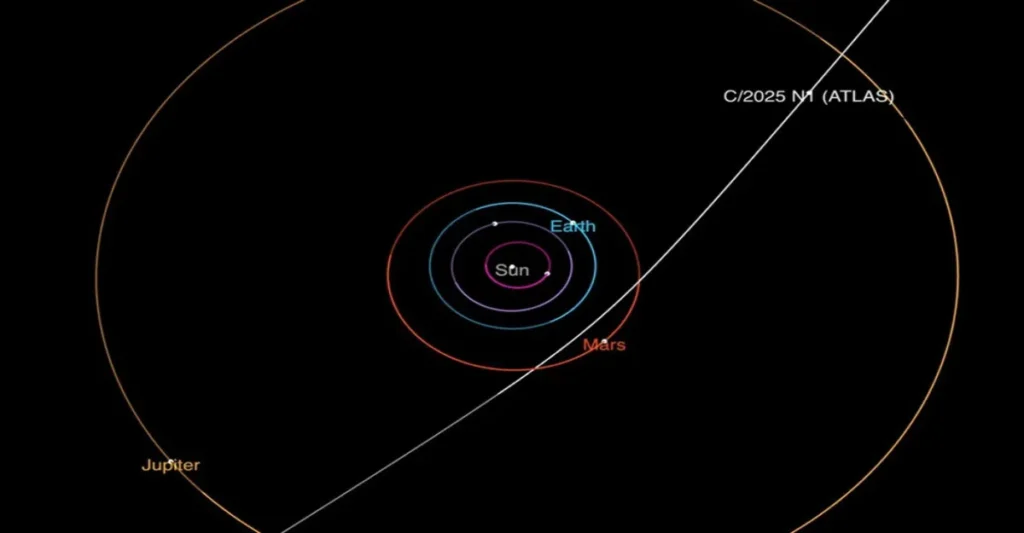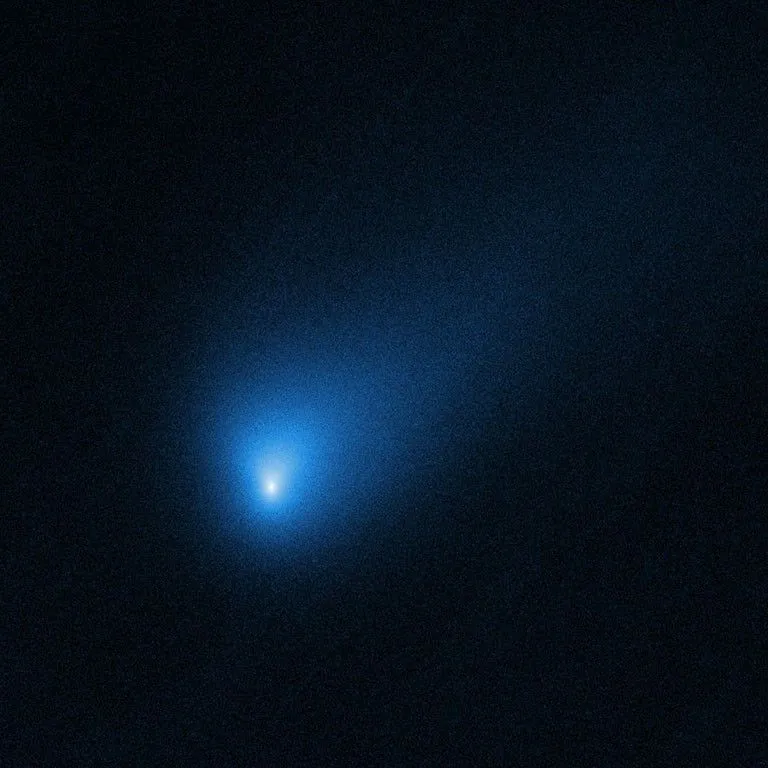Astronomers have announced that a new comet, nicknamed 3I/ATLAS, is hurtling through our Solar System from interstellar space. This is only the third known object ever detected coming from beyond our Sun’s neighborhood. On July 1, 2025 the NASA-funded ATLAS survey telescope in Chile first spotted what appeared to be a comet.
Follow-up analysis showed it was not orbiting the Sun – it was coming from outside our Solar System. Arriving from the direction of the constellation Sagittarius, it has been officially designated 3I/ATLAS (C/2025 N1). (The “3I” prefix marks it as the third confirmed interstellar object after 1I/ʻOumuamua and 2I/Borisov.) At discovery, it was already about 4.5 astronomical units (≈670 million km) from the Sun. NASA’s scientists emphasize that 3I/ATLAS poses no danger to Earth – it will come no closer than about 1.6 AU (≈150 million miles) from our planet.
How was it discovered?
On July 1, the Asteroid Terrestrial-impact Last Alert System (ATLAS) – a network of robotic telescopes funded by NASA – detected a faint moving object in the Southern sky. At first it was logged as a possible near-Earth comet or asteroid. Within hours, astronomers noticed its motion was unusually fast and hyperbolic, meaning it could not be bound to the Sun’s gravity. By tracing the object’s path backward, teams found “pre-discovery” images from mid-June in the ATLAS archives and from the Zwicky Transient Facility (Palomar Observatory). All the early data together confirmed that this object came from interstellar space. The Minor Planet Center confirmed its new designation, 3I/ATLAS, on July 2, 2025. (It had been provisionally labeled A11pl3Z.)
Where did it come from?
The comet is on a steep, comet-like trajectory that cuts through the inner Solar System. Below is NASA’s diagram of its orbit relative to the planets:

Figure: Trajectory of the interstellar comet 3I/ATLAS (white line) through the inner Solar System. The Sun is at center, with the orbits of Earth and Mars shown. 3I/ATLAS comes in from above the ecliptic plane, passes just inside Mars’s orbit in late October 2025, and will then head back out into space (diagram: NASA/JPL-Caltech).
3I/ATLAS came in from a high speed and hyperbolic trajectory, indicating it is not a member of the Solar System. It arrived from the general direction of the Sagittarius constellation. In other words, it has been wandering between the stars. Astronomers believe objects like this formed around other stars and were later ejected by gravitational tugs. As astrophysicist Jonathan McDowell explains, passing stars can “tug on the ice ball, [free] it out” from its home system – launching it into a long interstellar journey until it happens to cross our path. (By comparison, most comets in our Solar System come from the Kuiper Belt or the distant Oort Cloud, but 3I/ATLAS did not originate in either place.)
Historical context: ʻOumuamua and Borisov
This discovery brings to mind the only two other interstellar visitors ever seen. The first was ʻOumuamua (1I/2017 U1), found in October 2017 by Hawaii’s Pan-STARRS telescope. ʻOumuamua flew by the Sun and out of the Solar System, and its nature puzzled scientists. It showed no obvious cometary tail even though it briefly brightened after perihelion; it was first called an asteroid until a subtle non-gravitational acceleration was detected, suggesting outgassing. In contrast, the second visitor, Comet 2I/Borisov, discovered in 2019 by amateur astronomer Gennadiy Borisov, looked and behaved like a normal comet.
Hubble images of Borisov showed a diffuse blue coma of gas and dust streaming from a small nucleus as it sped through the Solar System at about 177,000 km/h. NASA notes that “‘Oumuamua appeared to be a rock,” whereas Borisov was “really active, more like a normal comet”. (A Hubble photograph of 2I/Borisov is shown below.)

Figure: Hubble Space Telescope image of interstellar Comet 2I/Borisov in October 2019, about 418 million km from Earth. The bright nucleus is surrounded by a bluish coma of gas and dust (NASA/ESA, image credit D. Jewitt).
Like Borisov, the new 3I/ATLAS is cometary – it already shows a faint coma and maybe a short tail. Preliminary estimates suggest it may be much larger than its predecessors. Observers have suggested 3I/ATLAS could be on the order of 10–20 km across, which would make it by far the largest interstellar object yet detected (Borisov’s nucleus is only about 975 m across). The object also appears to be moving faster than the earlier two.
Why is it significant?
Every interstellar interloper we find is a rare opportunity. With 3I/ATLAS we have only the third known messenger from another star system. Its significance lies in the new science it enables. Because it formed around a different star and survived the long voyage here, studying its material gives a direct sample of another planetary system. For example, astronomers can measure the ratios of ices (water, carbon dioxide, etc.) and dust in its coma, looking for clues about the chemistry of its home. If organic molecules or even amino acids were detected on such an object, it would boost the idea that the “seeds” of life are common throughout the galaxy.
Additionally, 3I/ATLAS appears to be unusually large and active, so it can be observed for weeks or months. It will brighten as it nears perihelion (around 1.4 AU from the Sun in late October), giving telescopes time to characterize it. NASA reports that 3I/ATLAS should be visible with ground-based telescopes through at least September 2025, and will reappear after it rounds behind the Sun in early December. All these observations will tell us how similar or different this extrasolar comet is compared to familiar ones.
Ultimately, the discovery underscores the potential prevalence of such objects. Models suggest thousands drift through the Solar System at any given time, mostly too small or faint to spot. The recent success of ATLAS and other surveys means we’re entering a new era: next-generation observatories (like the Rubin Observatory in Chile) could find these interstellar visitors routinely. Each one will help us understand the diversity of planetary systems and the building blocks they share.
In sum: NASA’s announcement of 3I/ATLAS has excited astronomers and the public alike. It is a chilly, icy wanderer from beyond, racing through the inner Solar System at tens of kilometers per second. Though it won’t come close to Earth, it brings a priceless scientific gift: raw material from another star. By comparing it to ʻOumuamua and Borisov, and by studying its chemistry and orbit, scientists hope to learn about the universality of comets – and perhaps even hints of life’s ingredients – across the galaxy.
Sources: NASA’s Planetary Defense blog and science briefings for 3I/ATLAS; NASA Science pages on 1I/ʻOumuamua and 2I/Borisov; news coverage of the discovery.